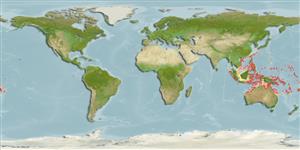Classification / Names
Common names from other countries
Main reference
Size / Weight / Age
Max length : 11.0 cm SL male/unsexed; (Ref. 48637)
Environment
Marine; reef-associated; depth range 10 - 40 m (Ref. 86942), usually 10 - 40 m (Ref. 27115)
Climate / Range
Tropical; 22°C - 28°C (Ref. 27115), preferred ?; 30°N - 24°S, 93°E - 174°W
Distribution
Short description
Dorsal
spines
(total): 7;
Dorsal
soft rays
(total): 12;
Anal
spines: 1;
Anal
soft rays: 12. Characterized by whitish or pale grey color ; 4-5 black to faint brown bars, anterior two much darker than others; head and body with bright orange spots; pelvic fins blackish; eye with black spoke-like markings; prolonged dorsal spines as short filaments; pelvic fins united by membrane at base of fifth soft rays; predorsal scales extending forward to above posterior margin of preopercle; longitudinal scale series 65-70; greatest depth of body 4.5-5.2 in SL; rounded caudal fin (Ref. 90102).
IUCN Red List Status (Ref. 115185)
Threat to humans
Harmless
Human uses
Aquarium: commercial
More information
Common namesSynonymsMetabolismPredatorsEcotoxicologyReproductionMaturitySpawningFecundityEggsEgg development
ReferencesAquacultureAquaculture profileStrainsGeneticsAllele frequenciesHeritabilityDiseasesProcessingMass conversion
Tools
Special reports
Download XML
Internet sources
Estimates of some properties based on models
Phylogenetic diversity index
PD50 = 0.5000 many relatives (e.g. carps) 0.5 - 2.0 few relatives (e.g. lungfishes)
Trophic Level
3.4 ±0.3 se; Based on size and trophs of closest relatives
Resilience
High, minimum population doubling time less than 15 months (Preliminary K or Fecundity.)
Vulnerability
Low to moderate vulnerability (27 of 100)
Price category
